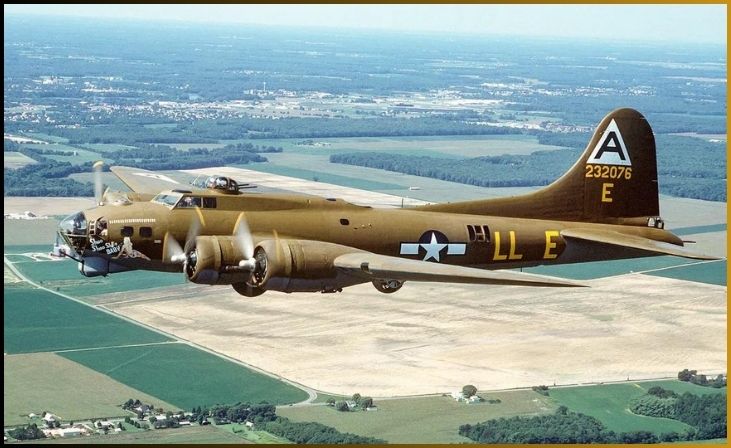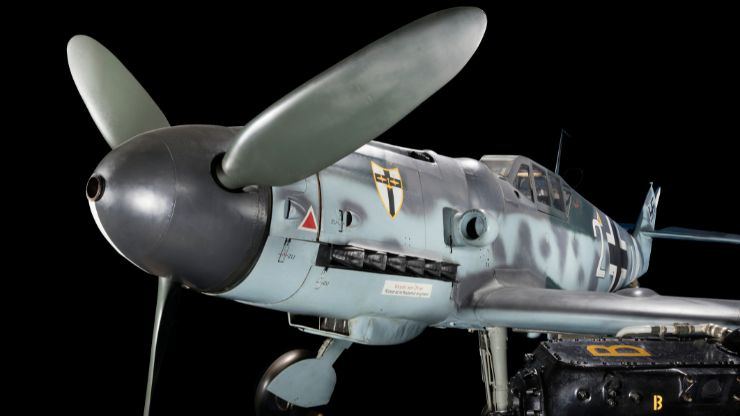World War II stands as a pivotal moment in human history, reshaping the global landscape and leaving an indelible mark on the course of nations. Amidst the vast array of contributing factors to the Allied victory, the role of aircraft emerged as a linchpin, holding paramount significance in America’s success during this tumultuous period.
As we embark on this exploration, our focus sharpens on “The 7 Planes America Used To Win WWII,” each aircraft a testament to innovation, strategic acumen, and the indomitable spirit of those who navigated the skies. These planes were not mere mechanical constructs; they embodied the aspirations, courage, and determination of the Allied forces.
In the crucible of war, where victory and defeat hung in the balance, the seven chosen aircraft played a crucial role in shaping the destiny of nations. From securing air superiority to delivering precision strikes that reverberated across continents, these planes were the vanguards of a new era in warfare.
The canvas of World War II witnessed a profound metamorphosis in the realm of airpower. This section delves into the intricate journey of airpower evolution during the war, highlighting not only the technological advancements that defined this era but also the strategic shifts that reshaped the very nature of aerial warfare. The evolution of airpower became a dynamic force, influencing the outcomes of pivotal engagements and laying the groundwork for the future of aviation.
Table of Contents
ToggleThe 7 Planes America Used To Win WWII
World War II marked a defining chapter in human history, and the contribution of aircraft played a pivotal role in shaping the outcome of this global conflict. Among the multitude of aircraft employed during this tumultuous period, seven distinct planes emerged as key players in America’s triumph. Each of these planes, with its unique design, capabilities, and strategic role, contributed to reshaping the course of history and securing victory for the Allied forces.
P-51 Mustang: Guardian of the Skies

The P-51 Mustang, often referred to as the “Guardian of the Skies,” ascended as an unparalleled symbol of air superiority during World War II. Its aerodynamic finesse, coupled with a robust and powerful engine, bestowed upon it an iconic status as a fighter aircraft. Designed to excel at high altitudes, the Mustang became a stalwart companion in escorting bombers deep into enemy territory, ensuring their protection and enhancing the strategic reach of Allied air operations.
Also Read:- QUARANTINED
The sleek contours of the P-51, crafted with precision, reflected not only a mastery of engineering but also a commitment to optimal performance. Its powerful engine, the Rolls-Royce Merlin, enabled it to outpace and outmaneuver enemy aircraft with unmatched efficiency. The P-51 was not merely a machine; it was a guardian, a vigilant presence in the skies that instilled confidence in Allied aircrews.
Capable of engaging enemy aircraft in dogfights with unparalleled success, the Mustang became synonymous with the defense of bombers and the establishment of air dominance. Its impact on the aerial theater was profound, altering the dynamics of air-to-air combat and contributing significantly to the success of Allied missions.
B-17 Flying Fortress: Aerial Fortress

The B-17 Flying Fortress, aptly named the “Aerial Fortress,” redefined the concept of aerial warfare. Its robust design and resilience in the face of enemy attacks made it a cornerstone in the Allied air campaign. As a formidable bomber, the Flying Fortress became a symbol of Allied power, reshaping the strategic landscape of bombing missions.
Endowed with the ability to withstand enemy fire, the B-17 became the workhorse of strategic bombing, delivering precise and devastating bombing runs on critical enemy targets. Its crew, facing the challenges of anti-aircraft fire and fighter opposition, demonstrated unparalleled courage and determination.
The Flying Fortress wasn’t merely a machine of destruction; it was a testament to the collective strength and resolve of the Allied forces. Its role in softening enemy defenses and disrupting wartime production facilities marked a paradigm shift in aerial tactics, contributing significantly to the eventual victory of the Allies.
Douglas SBD Dauntless: Naval Dominance

The Douglas SBD Dauntless, a stalwart in ensuring naval dominance, etched its place in history as a precision dive-bomber. Renowned for its accuracy in delivering bombs during dives, the Dauntless became a linchpin in securing control over the vast expanses of the Pacific Ocean.
With a design tailored for naval operations, the Dauntless showcased its effectiveness in anti-submarine warfare and precision strikes against enemy naval vessels. Its contribution to pivotal naval battles, such as the Battle of Midway, underscored its crucial role in turning the tide in favor of the Allies.
The Dauntless wasn’t merely a machine of war; it was a strategic asset that provided a decisive edge in naval engagements. Its impact on maritime operations highlighted the symbiotic relationship between technological innovation and the attainment of naval superiority.
Don't just scroll, subscribe!
BuzzTrail's unique web-stories are the cure for boredom you've been waiting for.
B-29 Superfortress: Atomic Aviator’

The B-29 Superfortress, standing at the forefront of long-range bombing missions, ascended to new heights with its groundbreaking role in atomic missions. This aircraft played a decisive role in bringing about the end of the war, reshaping the strategic landscape and leaving an indelible mark on the history of aerial warfare.
Equipped with cutting-edge technology, including pressurized cabins and remote-controlled gun turrets, the Superfortress was designed for extended missions over vast distances. Its most notorious missions included the dropping of atomic bombs on Hiroshima and Nagasaki, hastening the conclusion of the war in the Pacific.
The B-29 Superfortress wasn’t merely an aviator; it was the harbinger of a new era, where the strategic use of airpower could reshape the geopolitical landscape. Its legacy extended beyond the war, influencing the trajectory of global power dynamics and the future development of long-range bomber aircraft.
Lockheed P-38 Lightning: Versatile Vanguard

The Lockheed P-38 Lightning, heralded as the “Versatile Vanguard,” showcased unparalleled adaptability in the ever-evolving theater of wartime aviation. Serving in various roles, from escort missions to reconnaissance and ground attacks, the P-38 became a twin-engine marvel that seamlessly adapted to the dynamic demands of aerial warfare.
With its distinctive twin-boom design and twin engines, the P-38 offered a unique combination of speed, range, and firepower. This versatility allowed it to excel in roles that traditionally required different types of aircraft. The P-38’s adaptability made it a favorite among pilots and a valuable asset in achieving air superiority.
From escorting bombers to engaging enemy fighters, the P-38 Lightning’s impact reverberated across different theaters of war. Its contribution to reconnaissance, particularly during critical stages of the conflict, showcased its flexibility and underscored its significance as a versatile workhorse in the Allied arsenal.
Consolidated PBY Catalina: Maritime Marvel

The Consolidated PBY Catalina, celebrated as the “Maritime Marvel,” played a multifaceted role as a reconnaissance and anti-submarine aircraft crucial to maritime operations. Operating over vast oceanic expanses, the Catalina became an indispensable asset, providing invaluable information that shaped naval strategies and ensured the safety of Allied fleets.
Designed for long-range patrols, the Catalina’s endurance and ability to land on water added a layer of versatility crucial for maritime reconnaissance. Its role in anti-submarine warfare, patrolling convoy routes, and conducting search-and-rescue missions solidified its status as an essential component of Allied naval forces.
The Catalina wasn’t merely an aircraft; it was the vigilant eyes of the fleet, tirelessly patrolling the oceans and safeguarding maritime interests. Its impact extended beyond its primary functions, contributing to the overall success of Allied naval operations.
Grumman TBF Avenger: The Torpedo Bomber Titan

Amidst the turbulent skies and expansive seas of World War II, the Grumman TBF Avenger rose to prominence as a formidable torpedo bomber titan, carving out a niche as a vital component within America’s formidable aerial arsenal. Its distinctive role in delivering devastating blows to enemy naval forces marked the TBF Avenger as a linchpin in shaping the outcome of crucial maritime engagements.
Also Read:- FermUp A Podcast Review
Conclusion
As we draw the curtains on our exploration of “The 7 Planes America Used To Win WWII,” it becomes evident that these aircraft were more than just machines; they stood as profound symbols of innovation, courage, and determination. Their collective impact transcended the mechanical confines of aviation, leaving an indelible mark on the pages of history and reshaping the Second World War, ultimately ensuring victory for the Allied forces.
These planes, born from the ingenuity of engineers and the courage of pilots, represented the epitome of human achievement in the face of adversity. They were not mere amalgamations of metal and technology; rather, they embodied innovation, pushing the boundaries of what was deemed possible in the turbulent skies of wartime.
Innovation became the hallmark of these aircraft, as each plane showcased advancements that propelled the capabilities of aerial warfare to new heights. The P-51 Mustang, with its sleek design and powerful engine, exemplified the marriage of form and function. The B-17 Flying Fortress, a behemoth in the air, demonstrated the ingenuity of bomber design, while the versatility of the Lockheed P-38 Lightning highlighted the adaptability required for success in the ever-evolving theater of war.
FAQs
How did The 7 Planes contribute to the Allies’ victory?
How did The 7 Planes contribute to the Allies’ victory?
The 7 Planes played diverse roles, from securing air superiority to delivering devastating blows to enemy forces, significantly contributing to the Allies’ triumph.
Which plane had the most significant impact on naval operations?
Which plane had the most significant impact on naval operations?
The Douglas SBD Dauntless emerged as a naval powerhouse, its precision strikes proving pivotal in securing dominance at sea.

